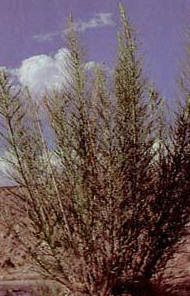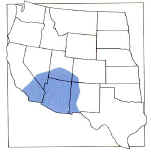|
 Copperweed is a perennial that may reach a height of 1.5 meters. A large number of stems grow from the crown; each has many narrow leaves. Small, flowering heads turn orange or yellow when mature. Copperweed is a perennial that may reach a height of 1.5 meters. A large number of stems grow from the crown; each has many narrow leaves. Small, flowering heads turn orange or yellow when mature.
When and Where It Grows
Copperweed grows along streambeds or gullies where moisture is plentiful and the soils are usually high in salt. It starts growing early in the spring. Flowers appear during July and August.

How It Affects Livestock
Cattle are more susceptible to copperweed poisoning than sheep. Ingestion of 1 1/2 kg of copperweed or an amount equal to 0.5 percent of the animal's weight may cause death. Poisoned cattle die in 24 to 28 hours. Poisoned sheep may linger 1 to 3 weeks before dying. Cattle and sheep generally graze copperweed when other feed is scarce. Cattle are more commonly poisoned and they are likely to eat the plant in the fall when they are being trailed from summer range. Sheep are occasionally poisoned in the fall and winter by eating dry leaves that have fallen to the ground.
Copperweed contains an unidentified toxin that is dangerous at all times. Toxicity reaches a peak when the plant matures. Leaves and stems are equally toxic.
Signs and Lesions of Poisoning
Loss of appetite
Dullness
Weakness
Coma and death in one to several days after ingestion of a lethal dose
Small hemorrhages on serosal surfaces
Mild gastroenteritis
How to Reduce Losses
Animals seldom eat a toxic amount of copperweed if other forage is available. To reduce losses, provide adequate forage at all times. Supplemental feeding is beneficial before animals are driven through heavily infested copperweed ranges. There is no known treatment for copperweed poisoning and research on herbicide control of copperweed is lacking. | 
